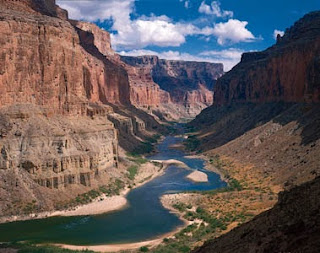Post
by Kristy McCaffrey
 The amazing spectacle that is Grand
Canyon, located in northern Arizona, has long defied description. And yet,
there’s no shortage of writers who’ve attempted to convey the vast contours and
depth of its landscape. Arizona author Leo W. Banks says, “All the descriptions
written over the decades land with a dull thud next to the real thing. It’s
because the Canyon is overwhelming. It is so personal, yet a beauty beyond us—a
far world, unknown, and unknowable.”
The amazing spectacle that is Grand
Canyon, located in northern Arizona, has long defied description. And yet,
there’s no shortage of writers who’ve attempted to convey the vast contours and
depth of its landscape. Arizona author Leo W. Banks says, “All the descriptions
written over the decades land with a dull thud next to the real thing. It’s
because the Canyon is overwhelming. It is so personal, yet a beauty beyond us—a
far world, unknown, and unknowable.”
The first written accounts of the
canyon date back to the 1500’s when the Spaniards entered Arizona and New
Mexico in search of treasure. Garcia Lopez de Càrdenas,
with the help of Hopi guides from the nearby mesas, became the first European
to see Grand Canyon. Unable to cross the impassable void, however, he left
frustrated.
 Native American tribes have
long occupied the area in and around the canyon, including the Anasazi (the
early ancestors of the Hopi), as well as the Hualapai and Havasupai tribes, which
occupy reservations in the western canyon. On the North Rim Paiutes worked
closely with the Mormons who colonized southern Utah and the Arizona Strip in
the 1850’s. The last American Indians to arrive at Grand Canyon were the
Navajo, or the Dine (Athabascan people related to the Apache), who moved there
from the Northwest around 1400 A.D.
Native American tribes have
long occupied the area in and around the canyon, including the Anasazi (the
early ancestors of the Hopi), as well as the Hualapai and Havasupai tribes, which
occupy reservations in the western canyon. On the North Rim Paiutes worked
closely with the Mormons who colonized southern Utah and the Arizona Strip in
the 1850’s. The last American Indians to arrive at Grand Canyon were the
Navajo, or the Dine (Athabascan people related to the Apache), who moved there
from the Northwest around 1400 A.D.
In 1857, Lieutenant Joseph Ives explored the area as part of a U.S. Army
survey party, stating pessimistically that “the region is of course altogether
valueless. Ours has been the first, and will doubtless be the last, party of
whites to visit this profitless locality.” Ives was soon proved wrong.
 |
| John Wesley Powell |
In 1869, Major John Wesley
Powell, a Civil War veteran with only one arm, and nine companions became the
first men to journey 1,000 miles on the Colorado River, part of it through
Grand Canyon. They braved rapids, heat, plummeting morale, and the loss of
three men. Powell’s account of this expedition, Exploration of the Colorado River of the West and Its Tributaries, made
him a national hero as well as brought the canyon to the attention of the
country. The
Paiutes called the plateau that the canyon cuts through “Kaibab”
or “Mountain Lying Down,” but it was Powell who first consistently used and
published the name “Grand Canyon” in the 1870’s.
 |
| El Tovar Hotel |
Mining
soon became popular but proved unprofitable due to the difficulty of extracting
and transporting ore from the canyon to the rim. A more lucrative, and less
dangerous, option presented itself in the form of tourism. In 1905 the famous
El Tovar Hotel opened on the South Rim. In 1908 President Theodore Roosevelt
declared Grand Canyon a national monument.
Many
stories and legends, some true, some exaggerated, have been told of Grand
Canyon and the people who’ve entered its depths. Poet, wanderer, and writer Everett
Ruess disappeared in the canyon at the age of 20 in 1934. He’s still searched
for today and sung about by medicine men. His legacy is his writings: “I
descended alone to the depths, to submerge myself in the steep silence, to be
overcome by the fearful immensity, and to drown everything in the deafening
roar of the Colorado, watching its snaking writhings and fire-tongued leapings
until I was entranced.”
~~~~~~~~~~~~~~~~~~~~~~~~~~~~~~~~~~~~~~~~~~~~~~~~~~~~~~~~~~~~~~~~
 |
| My mom, my daughter Katy and I on the South Rim. |
My book The Sparrow
takes place in Grand Canyon in 1877. Texas Ranger Nathan Blackmore accompanies
Emma Hart in a wooden dory down the Colorado River.
~~~~~~~~~~~~~~~~~~~~~~~~~~~~~~~~~~~~~~



Thank you for posting this article very interesting not so easy to get so much information.
ReplyDeletehttp://www.leonoraworld.com
Thanks for stopping by Leonora. Glad you found the post useful.
ReplyDeleteIt's unfortunate that many early explorers were only interested in monetary gain from their explorations and seemed to possess no spirit of wander or awe for natural landscapes. It took those with appreciation for God's creation to really see the humbling beauty of places like the Grand Canyon, Yellowstone and the great Redwood Forest.
ReplyDeleteThis was a wonderful and informative series, Kristy.
Thanks for stopping by, Sarah!
DeleteThank goodness those places remain intact with minimal intervention from man.